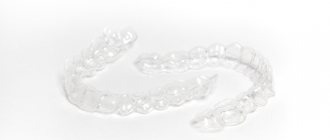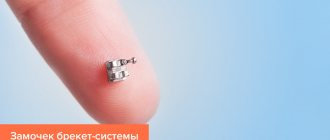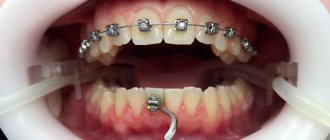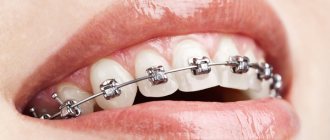Braces are the best way to correct bite anomalies of varying complexity in adolescents and adults. Many companies produce such equipment. To understand which design is suitable for the patient, it is important to know the features of brace system models. Implantmaster dental specialists have the skills to work with a variety of systems and select the best option for each specific clinical case.
Braces systems are designed to correct the position of teeth and jaw closure in adolescents and adults. Each age category has its own characteristics of the structure of the jaw bone and the time required to correct the position of the teeth. It is also important to consider the patient's psychological comfort. For some, the aesthetic qualities of systems are important, for others, the speed of achieving results or the material component.
The installation of various systems that correct the bite is carried out by our orthodontists. Doctors often improve their skills by attending training seminars and lectures. For successful work, the clinic has all the necessary high-tech equipment. We provide services at reasonable prices.
In this article you will learn when braces are installed and what types they are. Let's compare the characteristics of various braces systems and their costs. Let's determine what equipment is used for different ages.
Installation of braces in adulthood
Orthodontic treatment with braces in Russia goes back about thirty years. And in the USA, for example, bite correction with braces has been practiced for more than a hundred years. Russian orthodontists today often work with adults who simply did not have the opportunity to undergo this level of treatment in childhood. As a rule, such patients themselves turn to the dentist, less often - through the referral of related specialists. As a rule, people come to orthodontists for a beautiful smile, and not because of any pain. Most of those applying are women. Men are more relaxed about imperfect smiles, although doctors have recently noted an increase in the number of male patients.
Does it make sense to get braces as an adult?
Correcting a pathological bite or incorrect position of teeth is, of course, not a matter of life and death. Rather, it is a matter of regaining self-confidence. The “curvature” of teeth has little effect on communication; after all, we perceive a person holistically, and not solely the state of his bite. But, you see, an open wide smile of any person will make him more attractive in our eyes. And only people who are not embarrassed to show off their teeth smile like that. Plus, when we talk about bite, it's not just about beauty, it's also about functionality. Nature intended that when chewing, the load on the teeth should be distributed evenly - this is only possible with straight teeth and a healthy bite. If this is not the case, then over time a person develops problems with the dental system: pain appears, clicks when opening and closing the mouth, etc. Therefore, orthodontic treatment for adult patients is not only possible, but also necessary.
At what age does it make sense for adults to get braces?
In any case, there are no age restrictions. There are surmountable obstacles: the general condition of the teeth, periodontal and gum diseases, and possible common concomitant diseases. Absolute contraindications for installing braces for adults coincide with many other types of treatment: lack of teeth, tuberculosis, diabetes, a number of immune diseases, epilepsy, bone pathologies, blood diseases. If a person gets braces when he is over thirty, the treatment will be quite long, since tissue regeneration occurs more slowly due to age. Plus, skeletal growth has already been completed, and the position of the bones can be “corrected” only when they are still growing - in childhood and adolescence. However, dentists achieve excellent results with mature patients.
Indications and contraindications for installation
There are many indications for installing braces, but the main one is the alignment of the dentition, the correction of malocclusion (disturbance in the alignment of the upper and lower rows of teeth). Correct bite implies complete coverage of the lower incisors by the canines, and the chewing surfaces of the back teeth should touch the part that is closer to the inside of the oral cavity. Otherwise, there are indications for installing braces. This system is also recommended for the following jaw anomalies:
- Open bite. The dentition does not close in the lateral or anterior area. Installation of braces is one of the stages of treatment.
- Facial asymmetry. This pathology is most often caused by the hypertrophied development of one of the jaws, but the second jaw remains underdeveloped.
- Crossbite. It appears when one of the jaws is underdeveloped and slightly shifted to the side, however, both the lower and upper rows of the dental arch are not located exactly above each other.
- Crowded teeth. The teeth are rotated around their axis.
- Deep bite. The anterior part of the upper jaw excessively overlaps the lower jaw.
- Diastema and trema. Too much space between teeth.
- Distal bite. Violation of the position of the jaw (the upper one protrudes significantly forward).
- Medial bite. The lower jaw protrudes strongly forward. Most often, orthodontic appliances are used as the only treatment option.
The bite and development of the jaws are checked by a dentist whose specialty is orthodontics. It is he who prescribes treatment if necessary, and also installs the system in accordance with the type of bite.
Despite the fact that this is a fairly simple system that allows you to solve such global problems as correcting the bite, it has a number of contraindications; if they exist, wearing the structure is not recommended or is significantly limited. There is a conditional division of contraindications, which are relative and absolute.
16 photos in the style of what was then:
Relative ones are a temporary reason for refusing to use a system such as braces (the results will also be positive), after which the structure can be used. These reasons include:
- various neoplasms in the oral cavity;
- periodontal disease or periodontitis in the acute stage;
- the presence of metal implants in the oral cavity;
- bruxism (unconscious grinding of teeth during sleep);
- insufficient oral hygiene;
- allergic reactions to the material used to make braces;
- diseases of bone tissue with damage to the temporomandibular joint.
Absolute contraindications include those causes that cannot be eliminated. Therefore, to restore the correct bite position, orthodontists resort to other treatment methods. A contraindication to installing braces may be the presence of diseases such as:
- tuberculosis;
- diabetes;
- HIV;
- blood diseases;
- autoimmune diseases;
- oncology;
- mental illness;
- absence of a large number of teeth.
Those who are about to install a braces system are certainly interested in knowing what braces look like. However, this design is quite complex, so it is better to familiarize yourself with it at an appointment with a specialist or in a picture.
Specifics of treatment with braces in adults
Adult patients should keep in mind that it is often necessary to remove teeth to achieve a high-quality result of orthodontic treatment. This does not mean that every patient needs it; removal is carried out only in cases where there is not enough space to restore the normal position of the teeth. Foreign orthodontists change the jaw size of adults using surgery. In Russia, orthognathic surgery is not yet particularly widespread due to the fact that our patients are extremely reluctant to agree to undergo operations. Let us repeat that this is just information about how it might be. In most cases, orthodontic treatment for adults is limited to simply installing braces.
Stage No. 2. Diagnostics
Diagnostic measures usually take from half an hour to an hour and consist of the following:
- orthopantomogram - a panoramic image of both jaws;
- teleroentgenogram (TRG) - a photograph of the skull in frontal and lateral projection;
- photographing teeth, as well as the face in profile and full face;
- taking impressions of both jaws.
Based on the diagnostic results, the doctor draws up an individual treatment plan for braces and virtual simulation of the result. All information is entered into the outpatient card, and the patient is referred to doctors of related specialties.
Which braces are most often installed in adults?
It is most rational to choose metal braces: they are the most durable, and since the treatment will be long, this is one of the most important indicators. When it comes to minor corrections, aesthetic systems made of ceramics or artificial sapphires can be installed. But, let’s say, ceramic braces are quite fragile compared to metal ones. If the ceramic lock is chipped, you will need to remove it and install a new one. And this is a waste of time: when the lock is re-glued, the treatment can be considered to begin anew. When choosing a brace system, it is best to listen to the orthodontist’s recommendations - the doctor selects or combines types of structures so that the treatment is as comfortable as possible.
What it is?
Braces are essentially just that part of the bracket system that is attached to the tooth, a bracket for attaching a steel arch (wire). In addition to auxiliary fittings (springs, ligatures, rings) for fixing and tensioning the wire, a bracket system is formed.
The sooner you see an orthodontist, the better, but there is no age limit for use.
The essence of braces is to correct bite defects that lead to wear and destruction of tooth enamel, the appearance of caries and a decrease in aesthetic perception:
- protruding lower or upper jaw,
- uneven overlap,
- curvature of the dentition.
Is it possible to correct an adult's bite without braces?
You can - with the help of aligners. These are orthodontic transparent aligners made of solid polymer. Despite their rather simple appearance, aligners cope well with both minor changes in the position of the teeth and quite serious pathologies of the dentofacial apparatus. When treating with orthodontic aligners, patient motivation is extremely important. Aligners are more often chosen by men - they think that this type of treatment is less problematic. But they often lack patience and remove the aligners as soon as they feel discomfort. And this is unacceptable if the patient expects a positive effect of treatment. Aligners need to be worn 22 hours a day - keep this in mind before choosing this treatment option. If you comply with this requirement, then treatment with braces will not be necessary - mouthguards are no less effective at restoring the anatomically correct position of the teeth and correcting the bite.
Operating principle
Structurally, braces are a rather complex technical system. Each tooth has its own bracket, and then they are all connected using an arch made of a special alloy. A distinctive feature of such an arch is that it is able to move and return to a given shape, which corresponds to the correct bite. Moving in a certain direction, the arch sets the teeth in motion, which move to where it is needed. The pressure force and arch rigidity required are not the same, so during the treatment process the orthodontist adjusts these parameters to achieve the desired effect. You can learn more about who an orthodontist is here. How often the rigidity of the arch should be changed is decided only by the doctor, who must take into account such parameters as the complexity of the pathology and the type of orthodontic structure.
What are the best “adult” braces according to reviews?
Most adult patients respond positively to lingual braces. They are fixed on the back surface of the teeth and are absolutely invisible to others. This type of braces has the lowest profile: the clasps of the systems are lower than all others, and therefore do not interfere with diction, do not irritate the mucous membranes, and do not scratch the tongue. Adults also often choose non-ligature ceramic braces - they are practically invisible, quite durable and cheaper than sapphire structures. When choosing a vestibular system that is fixed on the front surface of the teeth, it is worth considering that no matter what invisible material its clasps are made of, the orthodontic arch will always be noticeable. Therefore, you can safely choose classic metal braces. Ultimately, preference for a particular design comes down to its price.
Our team of doctors
Maxillofacial surgeon, Implantologist
Bocharov Maxim Viktorovich
Experience: 11 years
Dental surgeon, Implantologist
Chernov Dmitry Anatolievich
Experience: 29 years
Orthopedist, Neuromuscular dentist
Stepanov Andrey Vasilievich
Experience: 22 years
Endodontist, Therapist
Skalet Yana Alexandrovna
Experience: 22 years
Orthopedic dentist
Tsoi Sergey Konstantinovich
Experience: 19 years
Dentist-orthodontist
Enikeeva Anna Stanislavovna
Experience: 3 years
Metal braces
Standard and reliable equipment for correcting jaw and dental disorders of any complexity. There is little aesthetics here because it stands out against the background of the teeth enamel. The lack of aesthetics of the design is compensated by the quick and high-quality achievement of the result. Implantmaster uses self-ligating metal plates from the Damon model range.
Pros:
- correct pathologies of varying severity;
- daily hygiene care is very simple;
- reasonable price;
- strength (the highest among orthodontic plates);
- the color of the equipment does not change under the influence of food;
- short treatment periods.
Minuses:
- Injury to the soft tissue structures of the oral cavity and tongue is possible.
- Noticeable when smiling or talking. Some patients refuse this model due to aesthetic discomfort.
- Allergies may occur.
Ceramic braces
The shade of such equipment matches the enamel of the teeth and is almost invisible during conversation. For the smile zone or for all units, taking into account the opinions of patients, Implantmaster specialists can offer a self-ligating system made of Damon Clear ceramics. She is in great demand.
Pros:
- Productivity. Installed to correct severe pathologies of jaw closure.
- Does not stain when worn for a long time, taking into account all the rules of hygienic cleaning.
- Few doctor visits are necessary.
- Resistant to loads.
- Aesthetics and comfort throughout the entire course of treatment.
Minuses:
- Therapy takes longer than with metal equipment.
- The cost of the system is several times higher than that of a metal structure.
- The need for thorough cleaning of equipment and the oral cavity. It is not advisable for children and adolescents to record.
- An allergic reaction may occur.
Sapphire braces
Which braces are better: sapphire or ceramic? When choosing between these two categories of wafers, sapphire wafers are the best option. They perfectly combine aesthetics and durability. The components of the bracket system are made of artificial sapphire - a very durable, non-toxic and biocompatible material. The plates do not change color when exposed to food or drinks, tobacco, coffee or wine.
Recommended for installation when there are wide gaps between units and lack of space in the dentition.
Pros:
- Highly aesthetic (matches the natural shade of enamel).
- Does not stain.
- Does not cause discomfort.
- Does not damage soft tissue structures of the oral cavity.
- The pronunciation of sounds is not affected.
Minuses:
- The material itself is durable, but the plates can break due to crackers or chewing gum.
- Unpleasant sensations may appear when the gums are sensitive.
- Effective only in simple deviations.
- The course of treatment lasts longer than usual.
- Need special care
Invisible (lingual) braces
Fixation is carried out on the enamel of the teeth from the oral cavity (lingual). It turns out that the main positive feature of such systems is their concealment from others. The plates are invisible when talking and smiling.
Additional positive characteristics:
- Small size. Throughout the course of therapy, the patient does not experience discomfort, because adaptation to the plates occurs quickly.
- Application of 3D technologies. When installing the system, it is more convenient for a specialist to fix the plates and control the movement of units, as well as the correction of general pathology. Already when planning a treatment regimen, a doctor with extensive experience can imagine the step-by-step movement of units along the jaw model.
Negative:
- Compared to other equipment, pain is higher when moving units.
- Problems arise when speaking and pronouncing sounds. Logoneurosis may develop due to worries about speech disorders.
- There is a high risk of injury to the soft tissue structures of the oral cavity and tongue.
- The treatment period is much longer than that of the vestibular systems.
- Expensive.
Ligature-free braces systems
What are the best braces? Most specialists and patients consider self-ligating systems to be the best choice, regardless of their high cost. They do not include additional fasteners, which makes them more discreet when talking. Self-ligating equipment is universal and suitable for all patients with clinical cases of varying complexity.
Pros:
- various plate materials (ceramics, metal, plastic, sapphire);
- quick addiction;
- effectiveness;
- comfortable course of treatment;
- smooth movement of units due to the use of small forces from the arc;
- resistance to color change;
- visit a specialist once every 2 months.
Minuses:
- lack of results in severe pathologies of the maxillofacial area and temporomandibular joint;
- high cost.
Retainers: why are they worn after braces are removed?
A retainer is a device that looks like an arch. It is placed on the back surface of the teeth when braces are removed. This way the new position of the teeth is secured. The ligamentous apparatus of the teeth has muscle memory, so no matter how we move the teeth, they will tend to return to their “original” position. Wearing a retainer is an essential part of orthodontic treatment. This is especially true for people over twenty-five years of age. A retainer is installed for at least two periods of wearing braces: for example, the patient wore them for one year, then the retainer will need to be worn for two years. Foreign orthodontists generally argue that you need to wear retainers constantly - this is the only way to guarantee that your teeth will remain straight. In general, after some time the retainer can be replaced with a night guard or plate. But some kind of structure supporting the new position of the teeth will definitely be needed - this is a classic. Unfortunately, patients often neglect this stage of treatment, experience relapses and begin to talk about the ineffectiveness and uselessness of orthodontic treatment in adulthood.
How long should adults wear braces?
It is impossible to answer this question unambiguously: maybe one year, or maybe several years. Bite correction in adult patients is a long, labor-intensive process that requires patience and discipline. Therefore, orthodontists rarely persuade adults to straighten their teeth. If a person himself does not want this, then nothing will force him to conscientiously fulfill all the doctor’s demands. When treating adults with orthodontics, it is important that the dentist find a compromise between what he wants to achieve and what the patient wants to achieve. Orthodontists, of course, always strive to restore the perfectly aligned position of teeth, no matter how long it takes - at least three years, at least five years. The patient may get tired of the treatment and abandon it. The dentist’s main task is to honestly tell you how long the treatment will take and how it will proceed. And then hear whether the patient is ready to go this route.
Price of braces for adults in Moscow
To avoid misleading you, we will not indicate specific amounts. Because orthodontic treatment for adults is time-consuming and often requires additional or preparatory procedures, its overall cost cannot be low. But the opportunity to smile broadly without embarrassment is priceless at any age! Therefore, it makes sense to schedule a consultation with an orthodontist, no matter how old you are. After examination and research, the doctor will tell you the exact cost of treatment in your case.











